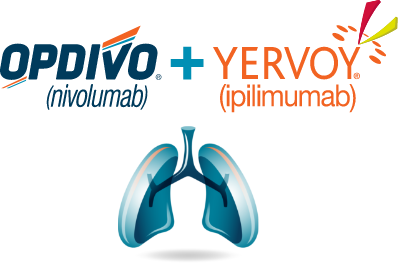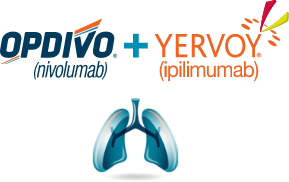See National Comprehensive Cancer Network® (NCCN®) Recommendation
CHECKMATE 227: IN A CROSS-HISTOLOGY TRIAL FOR PATIENTS WITH mNSCLC
(PD-L1 ≥1%)
Reset expectations: Durable survival with OPDIVO®
+ YERVOY®: 22% of patients alive at 6 years2*
A chance for
durable survival
OS FOR PD-L1 ≥1%
(EXTENDED FOLLOW-UP ANALYSIS)1-3


Between 2007 and 2013, prior to I-O approval,
the 5-year relative survival
rate for mNSCLC patients was 5%4†
Minimum/median follow-up for OS: 73.5/78.8 months.2
- Median PFS, with a minimum follow-up of 73.5 months, was 5.1 months (95% CI: 4.1–6.3) with OPDIVO + YERVOY and 5.6 months (95% CI: 4.6–5.8) with chemo; 0.80 (95% CI: 0.68–0.94)2,5‡
- 29% of patients enrolled had SQ disease; 71% had NSQ disease1
The only I-O combination with mDOR of 24.5 months among responders2‡
- ORR, with a minimum follow-up of 73.5 months, was 36% (n=144/396; CR=6.8%, PR=29.5%) with OPDIVO + YERVOY and 30% (n=118/397; CR=2.0%, PR=27.7%) with chemo2,5
- mDOR, with a minimum follow-up of 73.5 months, was 24.5 months (95% CI: 15.5–34.5) with OPDIVO + YERVOY and 6.7 months (95% CI: 5.6–7.6) with chemo2
Study design: Checkmate 227 was a randomized, open-label, phase 3 trial in patients with metastatic or recurrent NSCLC. Key eligibility criteria included patients 18 years or older, stage IV or recurrent NSCLC, ECOG PS 0/1, and no prior systemic anticancer therapy. Patients with known EGFR mutations or ALK translocations sensitive to available targeted inhibitor therapy, untreated brain metastases, carcinomatous meningitis, active autoimmune disease, or medical conditions requiring systemic immunosuppression were excluded from the study. Treatment continued until disease progression, unacceptable toxicity, or for up to 24 months. Tumor specimens were evaluated prospectively using the PD-L1 IHC 28-8 pharmDx assay at a central laboratory. In Part 1a (n=793), patients with PD-L1 ≥1% were randomized to either OPDIVO 3 mg/kg q2w§ + YERVOY 1 mg/kg q6w (n=396) or platinum-doublet chemotherapy* (n=397). The primary endpoint in Part 1a was OS in patients with PD-L1 ≥1%. Pre-specified descriptive efficacy measures included PFS, ORR, and DOR.1,6
vs chemo. In Checkmate 227, patients in the comparator arm received up to 4 cycles of platinum-doublet chemo q3w; NSQ: pemetrexed + carboplatin or cisplatin, with optional pemetrexed maintenance following chemo; SQ: gemcitabine + carboplatin or cisplatin.1,7
Data sourced from the SEER database.4
In Checkmate 227 Part 1a, PFS, ORR, and DOR were pre-specified descriptive analyses. The primary efficacy outcome measure was OS.1,7
The recommended dosage of OPDIVO per the Prescribing Information is 360 mg q3w with YERVOY 1 mg/kg q6w.1
1L=first-line; ALK=anaplastic lymphoma kinase; CI=confidence interval; CR=complete response; DOR=duration of response; ECOG PS=Eastern Cooperative Oncology Group Performance Status; EGFR=epidermal growth factor receptor; HR=hazard ratio; IHC=immunohistochemistry;
Select Important Safety Information
Serious Adverse Reactions
In Checkmate 227, serious adverse reactions occurred in 58% of patients (n=576). The most frequent (≥2%) serious adverse reactions were pneumonia, diarrhea/colitis, pneumonitis, hepatitis, pulmonary embolism, adrenal insufficiency, and hypophysitis. Fatal adverse reactions occurred in 1.7% of patients; these included events of pneumonitis (4 patients), myocarditis, acute kidney injury, shock, hyperglycemia, multi-system organ failure, and renal failure.
Common Adverse Reactions
In Checkmate 227, the most common (≥20%) adverse reactions were fatigue (44%), rash (34%), decreased appetite (31%), musculoskeletal pain (27%), diarrhea/colitis (26%), dyspnea (26%), cough (23%), hepatitis (21%), nausea (21%), and pruritus (21%).
Please see additional Important Safety Information below.







